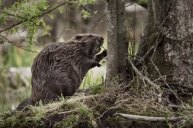Come along on the trapline as our man visits the sets, pulls critters and disseminates some of his experience and knowledge on trapping beaver.
Coon Creek Outdoors is a fine trapping and outdoors youtube channel. The trapper who runs the channel releases a ton of videos wherein he shares his expertise with the viewers. He holds nothing back.
I've learned a lot from watching his films. In this particular set of videos he invites us to follow him on his short line as he traps beaver.
The first set he shows is located in a creek's funnel area, where critters will necessarily travel. But he points out that he's a ways away from the beaver's home den, which is on private land that he doesn't have permission to trap. This situation necessitates him having to find areas where the larger beavers will travel every few days, such as this funnel area of the creek.
Next he walks up to a castor mound set that is about 50 yards from the animals' den. He wants to - and he does - catch a smaller beaver and says that the smaller animals tend to live and work closer to the den.
He talks about trap position as he shows the beaver's foot in the trap. When he sets the trap he situates it with the jaws at the 4:00 and 10:00 position (the hinge points are at the 1:00 and 7:00 positions) so that they don't kick the beaver's wide foot out of the trap as they close. It's little things like this that are the mark of an experienced trapper.
In the next set - another castor mound set - he's got a brute of a beaver in the trap. He places the trap in a location that forces the animal to begin walking into the set, and catches it by the right front foot. The set is simple, with the only adjustment being where he places the trap in relation to the rising or falling water level.
In the second video he starts at a pinch point in the creek. Examining the flow of water he indicates that the rushing water forms a V at its most powerful point. Every critter that moves down the creek will go through that stronger point. This is where he sets a conibear.
He comes back the next day and he's got a beaver right where he said he would.
Another tip he shares is to always work from the downstream side of the set in order to avoid kicking up stream debris and washing it into the trap set. Also, when placing funneling or directional sticks to guide the beaver into the trap, always use dead sticks. Avoid using green wood, or the beaver will stop to examine the fresh wood.
He again visits the castor mound set where he caught a beaver a couple days before. This time he's got a beaver by the other front foot. In these locations that are far from the den he indicates that you won't catch a beaver every day, but the beaver that you do catch will likely be the larger ones.
Each of the beavers he catches is dead when he arrives, as he makes either conibear or fast drowning sets. They are humane and ethically set traps that dispatch the animals quickly.
And here's a bit of beaver trivia: he mentions that the second inside toe on the back feet of beavers acts like a comb that the animals use to clean their fur. It results in a kind of "double toenail" on the beaver. I did not know that!
Like what you see here? You can read more great articles by David Smith at his facebook page, Stumpjack Outdoors.
NEXT: Randy Newberg Illustrates Muskrat Trapping, Fur Handling and Even Cooking
https://rumble.com/embed/u7gve.v3tsmt/




